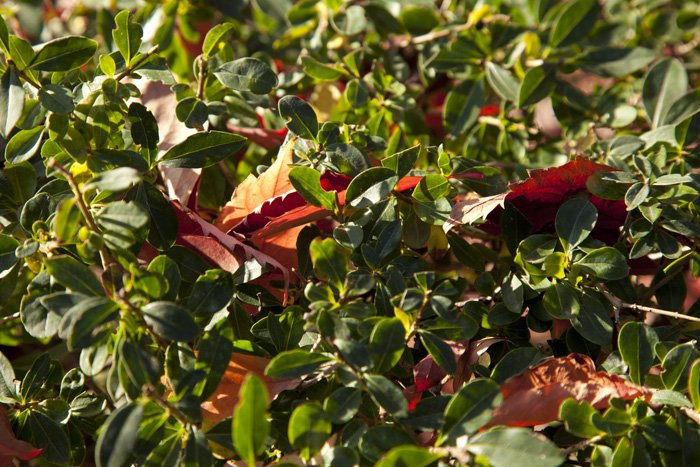
rethinking facades
facades and heat

I remember hot summer days when I would go for a walk in Berlin and all surfaces, facades and pavements alike, seemed to intensify the heat, make it more unbearable. And I thought, these kinds of naked stone dessert have something unescapable about them.
At some point, I started to wonder whether anything could be done about the nakedness of cities.
Taking a look at nature
Left to itself, nature avoids large, unbroken surfaces. In fact, if you look at trees, you will find two relevant aspects: A tree trunk is protected from the sunlight by hundreds or thousands of leaves. And those leaves are mobile.

Compare that to a house facade and you have the opposite: large unbroken surfaces ideal to soak up heat and not a bit of mobility.
Finding a way to protect a house from heat also means to reduce the heat a house emits. After all, a facade that has been warmed by the sun isn’t neutral, it becomes a source of heat itself.
How to break a facade’s surface and add mobile elements?
The easiest way is to use climbing plants and thereby benefit from nature’s effective way to avoid large surfaces.


This doesn’t necessarily look good all year round, but it is an effective protection.

Another possibility is to build facades of many small elements which are added at different depths. And these elements could be mobile, meaning these elements could be turned (for example whenever they reach a certain temperature).
Also possible is an imitation of leaves, either close to the facade or at a distance so that the leaves (made of wood or bamboo, for example) can move freely in the wind.
Puncturing the facade should also help to reduce the effect of sunshine on the surface.
And there is another intriguing idea. What if, a facade was made of two or three layers of artificial leaves (allowing for air circulation), and the outer leaves included solar cells, while all leaves can turn in a kind of socket thereby using the airflow to generate wind energy? Once someone finds out how to build such a facade, then a multitude of benefits could be gained:
- generating solar energy
- generating wind energy
- making the house independent of market prices
- protecting the facade from generating and storing unwanted heat
- creating a facade that doesn’t look naked
- and generally reducing the amount of unbroken surfaces
- plus offering shade for animals and humans
- cooling cities and towns
Questions to explore
What’s the trouble with house facades?
Trees – can their structure be translated into a design for facades?
How do trees interact with wind? How do buildings interact with wind?
How do big surfaces heat up compared to fractured surfaces?
Is there a difference between fracturing horizontally or vertically, or is a mixture best?
If buildings stored less heat and thereby gave off less heat, wouldn’t that reduce heat in general?
Which materials are best used for facades?
Those that store the least heat, and let through the least cold, and have no negative impact on the environment, neither in the production process nor while in use nor when their time is up.
What else can be rethought about facades?

‘I’ve been talking to Jason and his architects today,’ Maja said. ‘And we’re thinking about collaborating with artists for the facades of some buildings.’
‘Graffiti?’ Jack asked.
‘Maybe. But we focused on other artistic elements. Alice always talks about including surprises, and what better surprise than a hairy leg that’s halfway through a wall, or a clock with only half a face? Facade elements you wouldn’t expect. Jason wants to go over movies with you and look for inspirations.’
Jack chuckled. ‘I could make a list on the spot. I’ll find him first thing tomorrow.’
‘Good. And we talked about integrating mosaics and reliefs, the tamer kind of facade decorations.’
‘Some of us even added practical elements,’ Roger rumbled in his deep voice, looking up from his carving, ‘like plant boxes with a watering system, homes for birds and insects, a pulley so you don’t have to carry your shopping upstairs, an emergency toolbox with tools and bulbs, and a sundial for the poor buggers who only have half a clock on their facade.’
Landscapes as inspiration for town planning
A good result can probably be achieved by fashioning towns and cities like landscapes, and shaping them in all directions: different heights (of buildings and surfaces and as part of a building’s design), unevenly fractured surfaces (winding roads, random houses, random trees, random garden areas). Or in other words randomness on the ground levels, randomness in the composition of houses, trees and other elements within a town’s layout, randomness in the heights of all elements, randomness used on the facades of houses.
Isn’t it remarkable that nature has little visual structure and sameness, while humans seem to be obsessed with repeating pattern?

Nature isn’t repetitive as such. It always creates variations. It always creates uniqueness. That’s why it’s doubly strange that we use so many simplifying and generalising brands, instead of acknowledging diversity and abundance.
Heatwave special
During a heatwave in 2022, I noticed how much my glass windows heated up and thereby heated my flat, even though I had covered the windows.
This made me consider testing what would happen if I covered the windows from the outside.
The notes of my experiments are compiled in the Heatwave special >
More building ideas
You can find more thoughts and ideas on buildings and building in the dot.international book, chapter dot. as a blueprint, coex building.
back to: rethinking towns & cities


